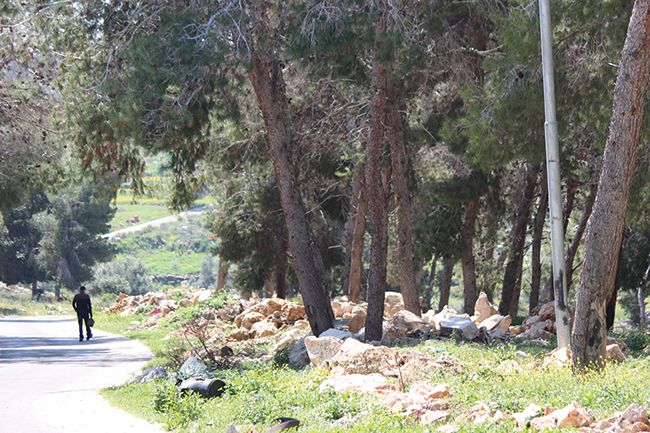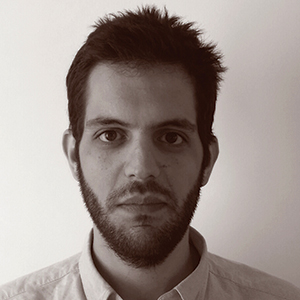
Although everyone in Palestine fancies himself a political analyst, I would not dare to try to define Area C. Such a definition is a job for someone specializing in the arcana of the Oslo Accords. All I know is that Area C is a name given to certain expanses of land in the country where I live. These expanses of land are under heavy restrictions for Palestinians; and sometimes it seems that all of Palestine is an Area C.
As spaces go, Area C is weird. It is a mystery, a non-zone caught in a state of uncertainty. At stake in these areas are the control of natural resources, the free use of Palestinian land, the building of settlements, and the slow destruction of whatever is left of the integrity of Palestine.
French philosopher Michel Foucault created the concept of heterotopia, which he uses to describe spaces that are ‘parallel’ because these spaces contain undesirable bodies. Area C is a place where Israel can ‘dump’ unwanted Palestinian bodies. Unwanted Israeli bodies are dumped there as well: settlers are the crux of colonization, but Israel does not really like them. They are used as willing cannon fodder in Area C, but I doubt the upper-class society in West Jerusalem would welcome a settler in its midst.
Defined by a transience of form, Area C is indeed a weird space: you never know if it is standing still or being annexed. Lands in Area C are always on the verge of disappearing. In a way, Area C does not even exist; it is the purgatory of Palestine, where lands are in waiting until they are annexed.
Area C is not a real space: it is merely the road map of colonization.
2.
When thinking about a title for this article, I toyed with different iterations of the same – ‘Area Crap,’ ‘Area Canine’ – all ways of suggesting that Area C is really, truly, undoubtedly, the crappy end of a really crappy deal. But I’m pretty sure everyone knows that today. Area C has come to represent the many ways in which Oslo has failed us.
After Oslo, the limits between different areas – A, B, C – in the West Bank were demarcated by yellow and gray concrete blocks. These blocks have fallen into disuse now, merely serving as reminders of the strange few years between Oslo and the Second Intifada. In Bethlehem, where I come from, you don’t need those blocks to let you know you’ve stumbled from Area A to Area C at night. You just need to listen carefully to the howling of dogs. Area Canine indeed, Area C is run over by stray dogs every night.
♦ “Area C is the purgatory of Palestine, a place where the road map of colonization is being laid out for all to see. A wonderland of injustice, it is at times horrific and – at times – magical. It has become the space where Israel dumps the unwanted bodies that do not fit within its lopsided utopia.”
There is a mystery in Palestine I have yet to solve. Everyone who’s ever driven from the north to the south has probably faced the same enigma. The ‘Container’ (yet another convenient C-word) is a checkpoint located east of Abu Dis, at the tail end of Wadi Nar. That specific check-point is empty, most of the time, save for a few bored soldiers and stray dogs. The soldiers and the dogs are on excellent terms, barely moving out of the way when Palestinian cars cross over. Every time I cross the Container I feel the same unease, as if I had walked into an alternate reality, a parallel Palestine, where dogs rule the land.
This has come to represent Area C to me: dogs and soldiers in what is de facto a no-man’s-land. But despite its being the road map of our disappearance, despite the uncontainable sprawling of settlements and the multiplication of land annexations, despite the way dogs and soldiers seem to spawn out of the darkness of Area C, Palestinians have found alternative uses to this elusive land.
If you’ve ever driven with a Palestinian, you must have noticed some strange mannerisms. For instance, he puts on his seatbelt as soon as he enters Area C; and the second he’s crossed over to Area A, like clockwork, he’ll remove the seatbelt as if it were a scorching reminder of the humiliations of the occupation. Because in some parts of Area C the military is on the loose, we have come to associate it with a certain form of law, or rather with a space in which there is no possible negotiation with the law, where the law is unfair and blind and illegitimate. Area C is where we are most vulnerable, where what passes for justice is a masquerade, a nightmarish carnival. Removing one’s seatbelt is an insignificant act. Seatbelts are not agents of the occupation. But the act itself is a way of navigating one’s lack of freedom. People in general will remove their seatbelts once they have reached a place that is considered safe: Palestinians remove them when they have safely left the unpredictable, shifting sands of Area C.
But Area C is also the space of another type of carnival, a more positive one perhaps. In Bethlehem and in Ramallah – I’m not sure about other cities – Area C is not just the reminder of the crappy end of the crappy deal. It is the kingdom of darkness. The roads are rarely lit. People seldom go there after dark. Area C, therefore, is where you go to get some peace and quiet. It is where you go to hide from the eyes of society. There, in the darkness, boys are boys, and girls are most certainly girls. I live in Area C. At night, car after car of what I assume are young couples drive up and down our street, living out bits and pieces of their lives far from the public eye. Heterotopias, as defined by Foucault, are also places where coming of age rituals take place: some of the naughtier rituals often take place in Area C.
3.
It is hard to define what exactly Area C is. The singular is misleading: Area C covers a diverse range of realities, all of which have in common that Israel has set its eyes on them and, by dint of bogus negotiations, is managing to annex them. Over the years, these areas have morphed into a strange monster with multiple limbs and a few too many genetic malformations.
In Macbeth – as in most of Shakespeare’s tragedies – the land changes, morphs, and bemoans the loss of its legitimate leader. As Macbeth takes over, the very face of the land changes; nature itself is unhinged and bares its teeth when faced with an unlawful prince. The land rebels when an impostor holds sway over it – because the ruler and the land are one.
Let us transpose this to another context: here, in Palestine, the people and the land are one. Area C is the physical manifestation of all that is wrong in our country; and as long as things stay as they are, Area C will remain a weird wonderland of injustice and insanity, a testimony to the twisted process through which we are made to disappear.
» “Karim Kattan is a French-Palestinian PhD student in comparative literature. In the summer of 2014, he founded el-Atlal, an international artists’ and writers’ residency in Jericho. Karim lives between France and Palestine.”


